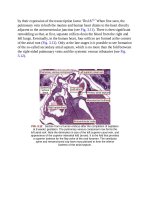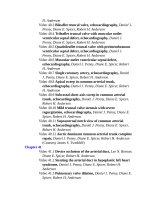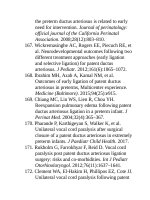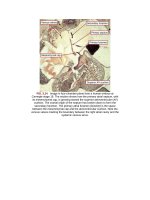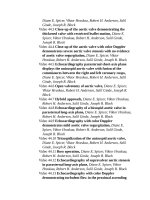Andersons pediatric cardiology 174
Bạn đang xem bản rút gọn của tài liệu. Xem và tải ngay bản đầy đủ của tài liệu tại đây (111.7 KB, 3 trang )
FetalVascularPhysiology
ArterialPhysiology
Theroleoftheendotheliuminmodulatingvascularresponsesiswellrecognized.
Aseriesofstudiesperformedinchildrenandyoungadultswithriskfactorsfor
laterdiseasehaveshownthatitispossibletodetectabnormalitiesinvascular
responsestostimulibothdependentandindependentoftheendotheliumbefore
therearesignsofovertdisease.181–183Althoughitisnotyetpossibletoexamine
directlytheresponsesofthefetalendotheliuminthisway,informationis
availableonthepulsationsofthevesselwallandthevelocityofthepulsewave
ofthefetalaorta,whichhavebeenmeasuredusingwall-trackingdevices.
Pulsationsofthearterialwall(Fig.6.19)reflectimpedancefromdistalvascular
bedsalongthefetalarterialtree.Thepulsatilechangeincross-sectionalareaof
thefetalaortaduringthecardiaccycleatthe20thweekofgestationis
approximately22%,fallingto17%attermcomparedwithapproximately9%in
theadultaorta.184Thismayreflectareductioninarterialmuralcompliancewith
increasingbloodpressureinthegrowingfetus,andwithstructuralchanges
withinthevesselwall,whichalteritsphysicalproperties.Informationaboutthe
fetalvasculartreemaybegainedfromanalysisoftheseparatepartsofthewall
asitmoves.Studiesusingafelinemodelhavecorrelatedthediameterofthe
movementsofthepulsatingwallwithinvasivemeasuresofventricularfunction
andafterload185andfoundthemaximalincrementalvelocityofthearterialpulse
waveformtobethebestsinglevariable,reflectingtotalperipheralresistanceand
latedecrementalvelocitybettertoreflectalowerstrokevolumeandreduced
cardiacoutput.Themaximumincrementalvelocity(seeFig.6.19)mayprovide
additionalinformationonventriculovascularcouplinginthefetalcirculation.
StandardarterialDopplerassessmentusingtheratioofaccelerationtoejection
periodsatthelevelofthearterialvalveissaidtoreflectthemeanarterial
pressureinthatarteryandalsotoreflectontheventricularfunction.
Unfortunately,thishasnotprovedtobereliable.186Incontrast,themaximum
incrementalvelocityhasbeenshowninanimalstudiestocorrelatewellwiththe
accelerationinaorticflowandwiththerateofriseofleftventricularpressure.185
Therateofincreaseintheaorticdiameterinearlysystoleisdependenton
ventricularsystolicfunctionbutisdependentalsoondistalimpedance.Ifthis
canbeconsideredtoremainrelativelyconstantforasingleexamination,then
maximumincrementalvelocitymaybeabetternoninvasiveindicatorof
ventriculovascularcouplingthancurrentlyavailableDopplermeasures.
FIG.6.19 Arterialpulsewaveform,illustratingthemaximumincremental
velocity(MIV),therelativepulseamplitude(ΔD),andthelatedecremental
velocity(LDV).Ddiast,Diastolicdiameter;Tprop,propagationtimeofthe
pulsewavemeasuredfromfoottofootofthearterialimpulse.
VenousPhysiology
Thevenoussystemisconsiderablymorepulsatileinthefetusthanafterbirth.
Pulsationsofthewalloftheinferiorcavalveinreflectnotonlythefetalcentral
venouspressurebutalsothechangesinventricularrelaxationandfilling.The
informationderivedhasprovidedinterestingphysiologicinsightsintofetal
circulatorydevelopment.184–187Incontrasttothearterialsystem,therelative
pulseamplitudeoftheinferiorcavalveinincreaseswithgestation.187The
relativegestationalincreaseinvenouspulseamplitudemayreflectan
improvementinthefillingandemptyingoftherightventricle.Thisissupported
bythefindings,usingDoppler,ofareductioninreversalofflowofbloodaway
fromtheheartintheinferiorcavalveinofthehealthyfetus.61That
venoventricularcouplingisfurtherimprovedissuggestedbythefindingof
forwarddiastolicflowinthepulmonarytrunkinnormallygrowingfetuseswith
increasedvenousmuralpulsatility.184Diastolicflowinthepulmonarytrunkhas
beenreportedinassociationwitharestrictiverightventricleinchildren
followingrepairoftetralogyofFallot,188butthesefetalDopplerindexessuggest
thatdiastolicfillingoftherightventricleimproveswithgestation.TheDoppler
findingssuggestthatimprovedfillingisaconsequenceofreduceddistal
impedancedrawingbloodintothearterialductattheendofdiastole,beforethe
valveopensfully.189,190Venousmuralpulsationsthereforemayreflectthe
fallingimpedanceofthearterialtreedistaltothearterialduct,aswellas
improvingcardiaccompliance.
PulseWaveVelocity
Measurementofcomplianceorelastanceofabloodvesselmaybedetermined
fromthespeedofpropagationofapulsetravelinginitswall:thefasterthe
velocity,thestifferthewall.Suchvelocityhasbeenshowntoincreaseby
approximately1m/sinchickembryosfromstage18to29191andinnormal
fetusesfrom20weekstoterm.184Thevelocitydependsonthemeandistending
pressureofthevessel,coupledwithchangesinthecompositionofthewall.The
meanaorticbloodpressureincreasesduringgestation,asdoesthethicknessof
theaorticwallrelativetothelumenandthesupportingadventitialtissue.The
compositionofthewallchangeswithaccelerateddepositionofelastinduringthe
lastweeksofgestation.Thiscontinuesduringthefirstmonthsoflifeandconfers
increaseddistensibilitytotheaorta.192Thevelocityofthepulsewavehasbeen
showntoincreasewithageandisanimportantdeterminantofcoronaryarterial
flowandleftventricularfunction.193Ithasalsobeenshowntocorrelatewith
atherosclerosisandtobeincreasedincoronaryarterialdisease.194Reduced
arterialdistensibilitycontributestothepathogenesisofhypertension.A
reductioninthearterialcharacteristicimpedanceresultsinincreasedpulse
pressure,andthepulsatilecardiacworkloadisaccentuated.Furthermore,the
resultantincreaseinthevelocityofthepulsewaveresultsinearlyreturnofthe
reflectedwaveandfurtheraugmentsthesystolicpressure.
